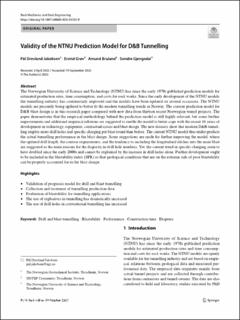| dc.contributor.author | Jakobsen, Pål Drevland | |
| dc.contributor.author | Grøv, Eivind | |
| dc.contributor.author | Bruland, Amund | |
| dc.contributor.author | Gjengedal, Sondre | |
| dc.date.accessioned | 2023-10-19T07:44:51Z | |
| dc.date.available | 2023-10-19T07:44:51Z | |
| dc.date.created | 2023-10-16T11:34:30Z | |
| dc.date.issued | 2023 | |
| dc.identifier.issn | 0723-2632 | |
| dc.identifier.uri | https://hdl.handle.net/11250/3097444 | |
| dc.description.abstract | The Norwegian University of Science and Technology (NTNU) has since the early 1970s published prediction models for estimated production rates, time consumption, and costs for rock works. Since the early development of the NTNU models the tunnelling industry has continuously improved and the models have been updated on several occasions. The NTNU models are presently being updated to better fit the modern tunnelling trends in Norway. The current prediction model for D&B blast design is in this research paper compared with new data from thirteen recent Norwegian tunnel projects. The paper demonstrates that the empirical methodology behind the prediction model is still highly relevant, but some further improvements and additional empirical relations are suggested to enable the model to better cope with the recent 16 years of development in technology, equipment, contractual-issues and blast design. The new datasets show that modern D&B tunnelling employ more drill holes and specific charging per blast round than before. The current NTNU model thus under-predicts the actual tunnelling performance in the blast design. Some suggestions are made for further improving the model, where the updated drill length, the contour requirements, and the tendency to including the longitudinal ditches into the main blast are suggested as the main reasons for the disparity in drill hole numbers. Yet, the current trend in specific charging seem to have doubled since the early 2000s and cannot be explained by the increase in drill holes alone. Further development ought to be included in the blastability index (SPR) so that geological conditions that are on the extreme side of poor blastability can be properly accounted for in the blast design. | en_US |
| dc.language.iso | eng | en_US |
| dc.publisher | SpringerLink | en_US |
| dc.rights | Attribution-NonCommercial-NoDerivatives 4.0 Internasjonal | * |
| dc.rights.uri | http://creativecommons.org/licenses/by-nc-nd/4.0/deed.no | * |
| dc.subject | Drill and blast tunnelling | en_US |
| dc.subject | Blastability | en_US |
| dc.subject | Performance | en_US |
| dc.subject | Construction time | en_US |
| dc.subject | Disputes | en_US |
| dc.title | Validity of the NTNU Prediction Model for D&B Tunnelling | en_US |
| dc.type | Peer reviewed | en_US |
| dc.type | Journal article | en_US |
| dc.description.version | publishedVersion | en_US |
| dc.rights.holder | © 2023 The authors | en_US |
| dc.subject.nsi | VDP::Teknologi: 500 | en_US |
| dc.source.journal | Rock Mechanics and Rock Engineering | en_US |
| dc.identifier.doi | 10.1007/s00603-023-03585-9 | |
| dc.identifier.cristin | 2185090 | |
| cristin.ispublished | true | |
| cristin.fulltext | original | |
| cristin.qualitycode | 2 | |

